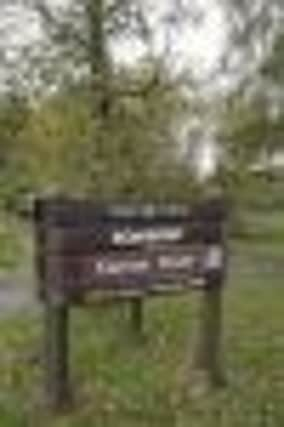KILLER TREE DISEASEOUTBREAK AT FOREST


Thought to have spread here from Scotland, the highly infectious disease called Phytophthora Lateralis was discovered by aerial photography after spreading to three public sites in Northern Ireland including Coleraine.
Only recently confirmed by laboratory analysis, P. Lateralis is on the Alert List of the European & Mediterranean Plant Protection Organization (EPPO). It primarily attacks Lawson Cypress and therefore could spread from public forests to decimate the garden centre industry which sells thousands of young trees every year for ornamental planting.
Advertisement
Hide AdAdvertisement
Hide AdUsing powers under the Plant Health Order (NI) 2006, restrictions to prevent the spread of the deadly pathogen are now underway in Coleraine which the Department of Agriculture and Rural Development (DARD) hopes will prevent the movement of infected soil from Somerset to other sites.
Unfettered dog walking has been banned, fencing is being erected to limit public access, resurfacing of paths is being conducted and signage is going up telling people to keep to the new contained sections and not remove cuttings for home planting.
A DARD spokesperson said: “At this stage Phytophthora lateralis has been confirmed by laboratory analysis on a number of Lawson cypress trees at Somerset Forest with up to about 20 trees currently showing symptoms. Inspections of Lawson cypress at the site are continuing. Lawson cypress however only represents a small percentage (less than 2%) of the forested area of Somerset. The disease was detected at Somerset as a result of aerial surveillance undertaken for P.ramorum.
“Phytophthora lateralis is primarily a soil borne disease. Lawson cypress trees become infected by spores in soil or water coming in contact with their roots. This is different to Phytophthora ramorum in larch trees which is spread primarily by airborne spores from foliage.
Advertisement
Hide AdAdvertisement
Hide Ad“Biosecurity measures are being put in place at Somerset to limit further spread both within and beyond the Forest. These concentrate on preventing the movement of infected soil.”
The spokesperson concluded: “Fencing is being erected to limit access to areas of current infection, some upgrading of the surface of paths is being undertaken and signage is in place at the forest to advise the public of the steps they can take to help limit the risk of spreading the disease. We would ask visitors to Somerset to follow the guidance on these signs.”
According to the Forestry Service, Phytophthora lateralis is a pathogen that kills the roots of host trees. Although it can potentially affect a number of tree species including other Chamaecyparis species and Pacific yew (Taxus brevifolia), it is a specific threat to Lawson cypress (Chamaecyparis lawsoniana), which normally die following infection.
The foliage of infected trees initially appears slightly lighter in colour than that of healthy trees; later on it withers and turns a reddish-brown colour, then the tree dies. As the pathogen extends from the roots and root collar up the trunks of affected trees, tongues of killed inner bark are visible by their darker colour, and the entire trunk can be girdled. There is no evidence that it can harm humans or animals.
Advertisement
Hide AdAdvertisement
Hide AdUntil recently the disease was largely confined to Canada and the United States, but outbreaks have been recorded in France and the Netherlands. The disease was first discovered to have infected trees at two sites in Scotland in 2010 before Ulster’s Forest Service detected it here at Tollymore Forest near Newcastle.
The Northern Irish discoveries, more widespread than in Britain, only came about as a result of helicopter searches by the Forest Service who were on the hunt for sister disease, Phytophthora ramorum, which attacks Japanese Larch Trees.
There are fears the two diseases could now combine to form a new hybrid infection. P. lateralis and P. ramorum belong to the same sub-group of the large Phytophthora group of organisms, which means they might be able to exchange genetic material. This could involve anything ranging from genetic modification of P. lateralis or P. ramorum to formation of a new species of Phytophthora. It is impossible to predict what the consequences of hybridisation would be but there is always a possibility that the new strain might be more virulent and infect species of trees and plants that the ‘parent’ species are not currently known to affect.
The Department of Agriculture said it has already stepped up its inspections of trees and plants at production nurseries and retailers following the discovery of more infected Lawson cypress.